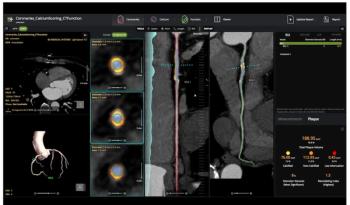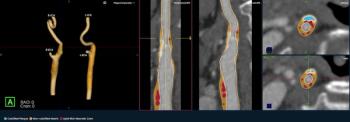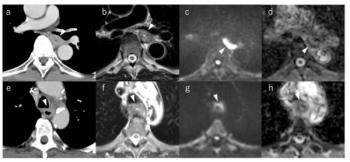
PET-CT With 18F-NaF PET-CT Detects High-Risk Coronary Plaques
PET-CT with the radioactive tracer 18F-NaF PET-CT helps clinicians detect ruptured and high-risk coronary plaques.
Images from 18F-NaF PET-CT allow clinicians to identify and localize ruptured and high-risk coronary plaque, according to a study published in
Researchers from the United Kingdom undertook a prospective clinical trial to determine if using PET and CT with radioactive tracers could help clinicians in the prevention and treatment of coronary heart disease.
Forty patients who had experienced a myocardial infarction (MI) and 40 who had stable angina were enrolled into the study. All underwent 18F-sodium fluoride (18F-NaF) and 18F-fluorodeoxyglucose (18F-FDG) PET-CT and invasive coronary angiography. The researchers compared 18F-FDG with histology in carotid endarterectomy specimens from patients with symptomatic carotid disease and with intravascular ultrasound in patients with stable angina.
In 37 patients (93 percent) with MI, the highest coronary uptake of radioactive tracer 18F-NaF was in ruptured (culprit) plaques (culprit 1·66 [IQR 1·40-2·25]) compared to un-ruptured, but high-risk, (non-culprit) plaques (1·66 [IQR 1·40-2·25]). A similar difference between culprit and non-culprit plaques wasn’t seen when researchers used the current, standard noninvasive tracer 18F-FDG (1·71 [1·40-2·13] vs 1·58 [1·28-2·01], p=0·34). Marked 18F-NaF uptake occurred with all carotid plaque ruptures and was associated with active calcification, macrophage infiltration, apoptosis, and necrosis.
Of those patients with stable angina, 45 percent (18 patients) had increased 18F-NaF uptake (maximum tissue-to-background ratio 1·90 [IQR 1·61-2·17]) associated with more high-risk features on intravascular ultrasound than plaques without tracer uptake, such as positive remodeling, microcalcification, and necrotic core.
The authors concluded 18F-NaF PET-CT is the first non-invasive imaging method to identify and localize ruptured and high-risk coronary plaque. They pointed out, however, that more study is needed to see if this is a feasible method to improve coronary artery disease care.
Newsletter
Stay at the forefront of radiology with the Diagnostic Imaging newsletter, delivering the latest news, clinical insights, and imaging advancements for today’s radiologists.






























